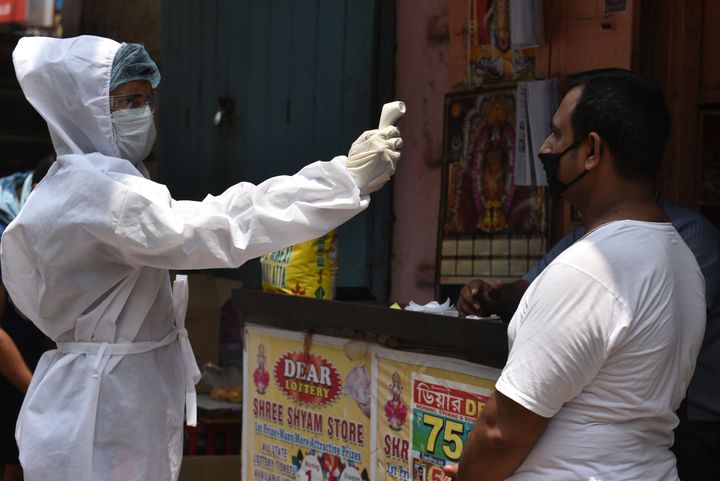
The West Bengal government on Monday declared four districts in the state as red zones and 287 containtment zones in Kolkata even as it said that there were 43 new coronavirus cases in the state in the last 24 hours.
Bengal chief secretary Rajiva Sinha claimed that West Bengal’s death rate was lower than national average, amid questions about the methodology Bengal was using to count deaths.
The number of deaths, according to the government bulletin, remained at 20 and 504 active cases. The state has had a total of 633 COVID-19 patients so far according to state government data.
Govt declares red and orange zones
The Mamata Banerjee government on Monday said that the state had four red zones — Kolkata, Howrah, North 24 Parganas and Purba Medinipur districts.
A PTI report said that 11 districts were declared as orange zones and eight are green zones.
South 24 Parganas, Hooghly, Paschim Medinipur, Purba Bardhaman, Paschim Bardhaman, Kalimpong, Nadia, Jalpaiguri, Darjeeling, Murshidabad and Malda are in the orange zone.
The eight districts in the green zone are Alipurduar, Cooch Behar, Uttar Dinajpur, Dakhin Dinajpur, Birbhum, Bankura, Purulia and Jhargram.
The report said that 287 areas in Kolkata, the majority of which are in north and central parts of the city, have been identified as containment zones.
There were eight containment zones in Purba Medinipur district, out of which there are five zones from where there has been no report of any new COVID-19 infection since April 9, Chief Secretary Rajiva Sinha said.
In the North 24 Parganas district, there has been no report of any COVID-19 positive cases from 13 zones out of the total 57 containment zones, he said.
He said that out of the 287 containment zones in Kolkata, there have been no cases from 18 zones in the last two weeks.
Sinha further said that in Howrah district there were 56 containment zones, and from 13 of them there has been no new case of conornavirus infection.
He said if no new case is reported from a zone for at least 21 days, the government will announce relaxation there.
For the latest news and more, follow HuffPost India on Twitter, Facebook, and subscribe to our newsletter.
Not allowed to speak at CM meet, says Mamata
As the tussle between the Narendra Modi government and Mamata Banerjee’s government in West Bengal continued, with the chief minister saying she was not allowed to speak to the PM during the meet.
The Telegraph quoted Banerjee as saying, “We were not allowed to say anything. We sat quietly, idly. Three hours, we only listened. Of course, the smaller states should be allowed to speak, but the bigger states, suffering a great deal, their opinion should have been sought.”
She said that while she did not mind that Bengal’s opinion was not sought, she would like to ask a few questions.
Banerjee said that it had been decided that only nine states will speak, but despite that Bengal attended the meet.
The West Bengal chief minister also said that there had been no clarity on what would happen after May 3.
Bengal claims great
Even as a state government panel said that there were 57 deaths in the state linked to COVID-19, the government continued to insist that only 20 people had died of the disease in the state.
If all the 57 deaths are counted, West Bengal would have one of the highest number of deaths in the country. But, Sinha said on Monday that coronavirus patients in West Bengal were getting “better treatment” than several other places and said the COVID-19 death rate in the state is 2.6% less than the national average of 3.1%.
“The case doubling rate in the first week of April was four days. In the middle of April, it was six days. Now, it is nine days. It is very, very close to the national average. It is a key indication of better case management and containment,” The Telegraph reported Sinha as saying.
Kolkata, Howrah and North 24 Parganas had the most number of cases in the state.
According to The Telegraph, Sinha also said that the recovery rate of 18% — where there were zero recoveries in March and 109 now — was the same as the national average and better than most large states.
“The fatality rate in Bengal is 2.6 per cent, less than the national average of 3.1 per cent. This shows people in the state are getting better treatment,” Sinha was quoted by PTI as saying.
Banerjee also had no kind words for the inter-ministerial team that is visiting Bengal. According to Anandabazar Patrika, she said if they keep calling the chief secretary, the heath secretary, the home secretary and others to meet them every day, they would not have time to do their work.
Home quarantine
The West Bengal issued guidelines on Monday saying that primary or secondary contacts of COVID-19 patients can be placed under home quarantine if they had “reasonable living and physical spaces”.
“Those who have adequate space at home can remain quarantined in their homes if someone from the home tests positive for COVID-19. It spares the government the burden of shifting more people. You cannot take lakhs and lakhs of people to quarantine centres. The government has its limits,” Banerjee was quoted by The Telegraph as saying.
The government said that local health authorities would keep a close watch on such people even if they were in home quarantine.
The order clarified that this would not apply to COVID-19 positive patients.
(With PTI inputs)